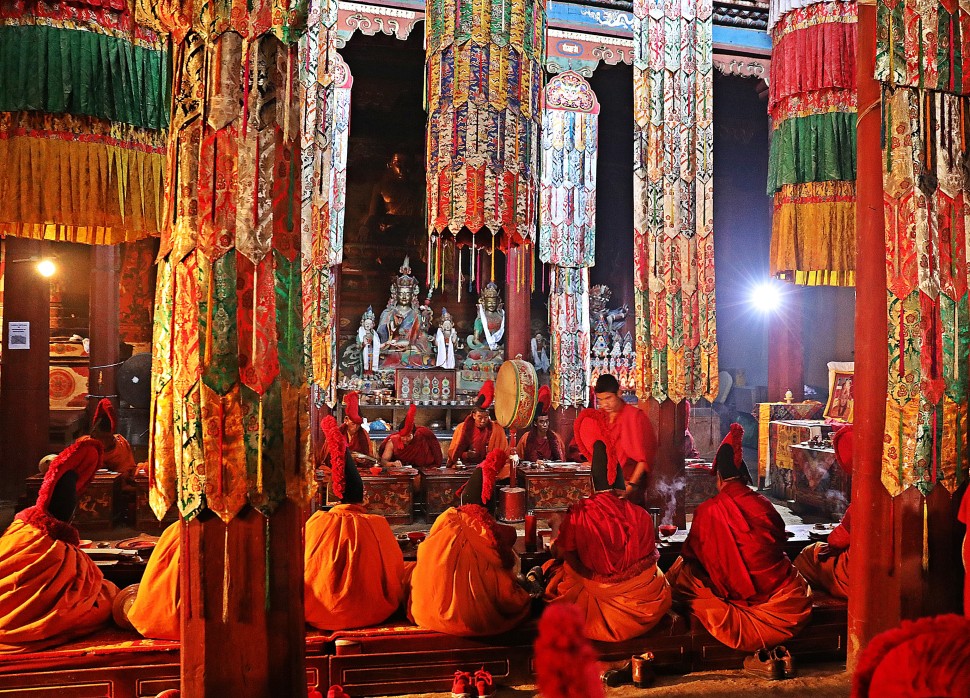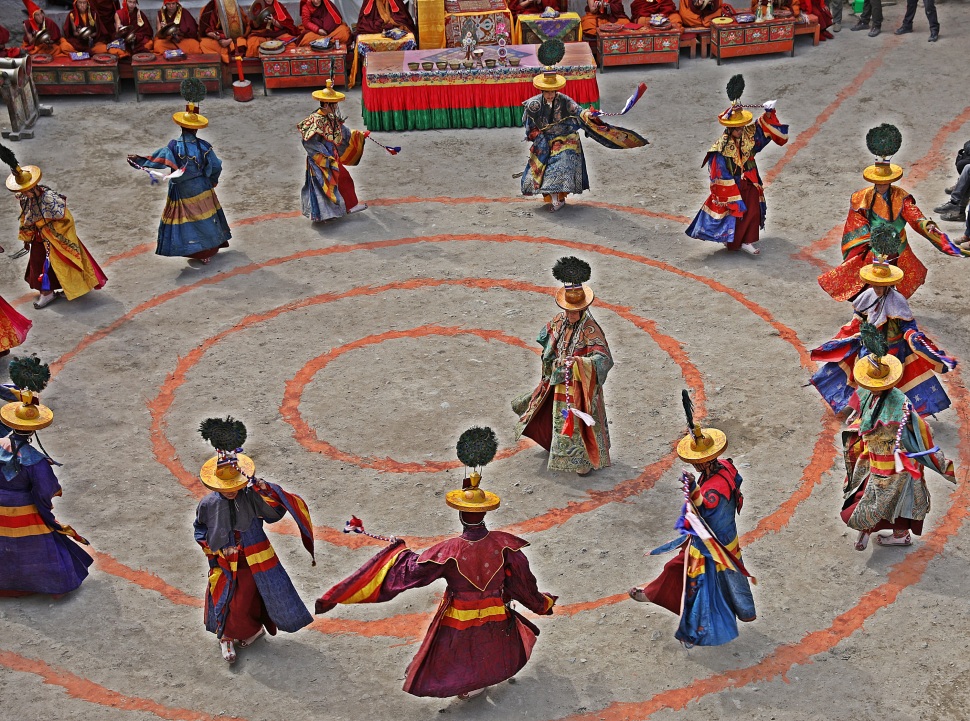Upper Mustang in northern Nepal is an arid, mountainous area settled by Tibetans generations ago. The Tibetan culture along with the landscape make this area one of the most interesting parts of Nepal. We trekked for 5 days to reach the area`s former capital, Lo Manthang, to attend the annual Tiji Festival.To read Part 1 of this trek click here. For details on the trek click here.



Lo Manthang is a walled town a 4-hour walk from the Tibetan border. Last century it was an important town on the salt trade route from Tibet. Today, the wall remains as do most of the buildings in the old town inside the wall. The maze of narrow sidewalks takes you past ancient 2 story, compressed-mud houses all connected to the next by a shared wall and roof.









The homes are arranged for the animals to live on the ground floor and the family`s kitchen/living/dining room and bedrooms on the 2nd floor. The kitchens have a stove in the centre that burns dried yak dung. It is very dark inside as there is only one small window to let in light and electricity is only used for a few hours in the evening. We were lucky to be invited for tea with an interesting lady in her house. 2 of her 3 sons are Buddhist monks and her daughter is a painter helping to renovate one of the temples in town.



There are 4 Gumbas inside the walled city. The Jampa Gumba was built in the 14th century with 5-feet thick walls. It has a small temple with 108 mandalas (spiritual charts) painted on the walls in silver and gold. The Thupchen Gumba has a large main hall with 30 massive wooden pillars. At the front are old decorated chortens and Buddha statues. The high ceilings are decorated with carvings and have huge, colourful tapestries hanging from them. The centre of the hall is arranged for pujas with 4 rows of seats and desks for the lamas and their many instruments. The pujas at this monastery were the most impressive that we’ve seen. There were at least 50 lamas in attendance wearing traditional head gear. The main lama chanted mantras over a loud speaker while the others followed along. Throughout the chanting the various instruments are played giving the ceremony a mystical feel.




North of the city is a very old settlement, Chhasar, with monasteries and caves from the 9th century. The Chemba-Concoling Cave Gumba is built on a cliff on the side of the mountain. It’s an impressive architectural display. Inside is a very small, simple temple. Near it is Lo-Gurfa Gumba built during the same time with Buddha figures painted on a wall in silver.



There are numerous caves in the area, high up on the shear rock face. Some of the caves were used as burial sites and some were lived in by hermit monks or even by entire villages. We were able to enter one cave using a new staircase. Inside the cave are dozens of small rooms, some with small windows but many are in dark corners. The cave has 4 stories with narrow openings between each floor. There are now wooden ladders between the floors. It’s remarkable to think that people lived in these caves hundreds of years ago.






The main reason for coming to Lo Manthang was to attend the annual Tjii Festival. This traditional festival began in the 17th century when a demon was wreaking havoc on the kingdom. A Buddhist Deity won a battle with the demon and even today the lamas believe the festival must occur yearly in order to keep the demon from returning. Held in one of the Gumba’s open plazas, the 3-day festival involves lamas dressed in bright costumes performing different ritualistic dances. At the front of the dance floor is a long table where the high-ranking lamas from the surrounding areas sit in traditional dress. They play the musical accompaniment to the dances with their oboes, dung chens, drums and cymbals. The lead dancer is in the middle of a large circle while the rest dance around him. The lead dancer is kept in seclusion for the 3 months prior, so he can meditate in preparation for the upcoming event. The costumes begin with brightly coloured coats. elf-style shoes and bright yellow hats with peacock feathers.












On the second day the lamas wear giant masks of animals and mystical creatures. The edges of the plaza were filled with locals from the surrounding communities as well as tourists. There was a celebratory atmosphere to the crowd and you could tell It is a very important tradition for the community.












After 2 days of the festival we started to make our way back down to Jomsom. The trek mostly retraced the same path we took on the way up. On the day of our flight the weather in Jomsom was nice, but it was storming in Pokhara. Planes fly using visual navigation, so all flights were cancelled for the day. Instead of waiting until the next day, we decided to take a 7 hour jeep ride to get to Pokhara. Unfortunately, the 160 km drive took 11 ½ hours. It was on a muddy, pot-hole ridden, busy gravel road that was only wide enough for a single car, and yet cars and trucks somehow managed to pass each other with inches to spare. Eventually we made it to Pokhara where we only had a few hours to prepare for our next adventure.
Coming up next, A Trek Around Manaslu
For pictures from our Annapurna trek click https://www.youtube.com/watch?v=IGL5XQNaWm8
For pictures from Richard’s Everest Summit click https://www.youtube.com/watch?v=VFmsecd6yN0
For extra pics from this trip go to Gallery/Nepal. For extra pictures from other blogs go to Gallery at monkeystale.ca
If you like what you read, please share it using the links below.
wow – looks fantastic!!! 😀
LikeLiked by 1 person
Thank you so much!!
LikeLiked by 1 person
Great pictures!
LikeLiked by 2 people
Thank you!!
LikeLike
Wanted to go to Mustang ever since I read the book “Mustang, The Forbidden Kingdom” by Michel Peissel (who detested meeting other trekkers, but then he should not have written a book inspiring people to go there). We saw the path from Kagbeni, but Mustang was still closed to almost all foreigners at the time, plus I was carrying my 3 1/2 year daughter, and we didn’t want to take her up to such high altitudes (don’t know with little kids whether they are cranky or have altitude sickness). Sounds like you two are having an amazing journey!
LikeLiked by 1 person
You should go there😊 But the hike is changing with more jeeps so the sooner the better.
LikeLike
Jealous. Upper Mustang is next in our nepal trek list.
LikeLiked by 1 person
There’s another festival in the fall too, I forget the name. It’s worth it to go at any time though.
LikeLiked by 1 person
Lovely photos. I like Nepal too, very interesting country to visit. I extend my visa when I was there last in 2011. ha..ha..
LikeLike
We love it too. We’re here for 3 months this time!
LikeLiked by 1 person
oh wouw… you have plenty of time to explore. Have fun there.
LikeLike